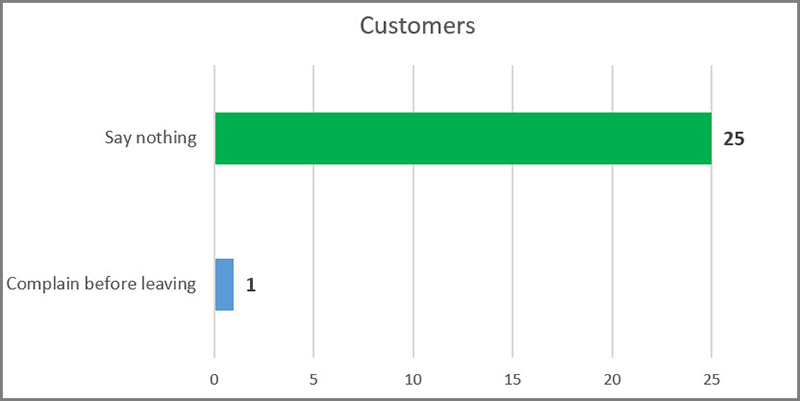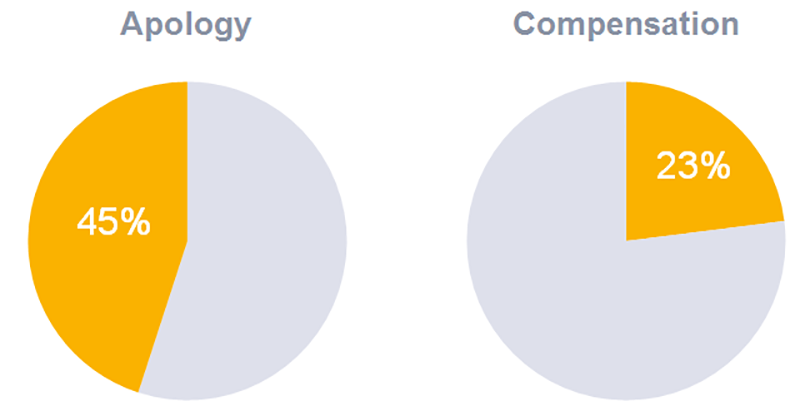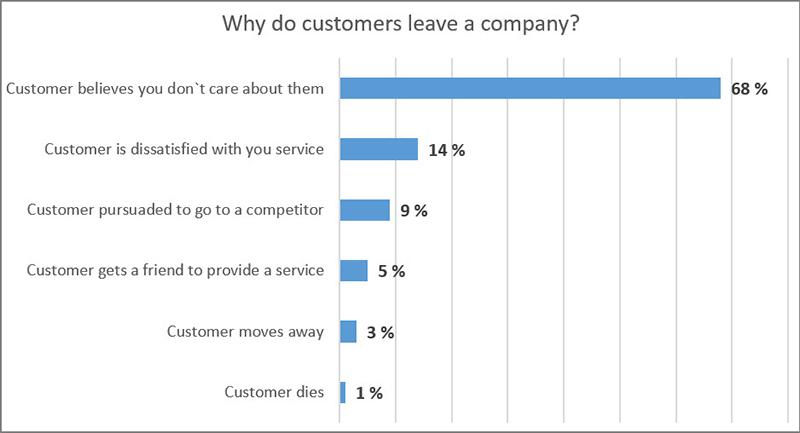In today’s Internet-driven world, customers have more power than ever.
If customers have a positive customer experience, they will share this experience with friends, family and connections, which in turn can lead to new business. All at zero cost.
But what happens if you fail to provide a positive customer experience?
The answer is simple. Your customers will complain.
According to research by Esteban Kolsky, 13% of unhappy customers will share their complaint with 15 or more people.
Furthermore, only 1 in 26 unhappy customers complain directly to you.

And for customers that don’t complain, they just stop doing business with you.
There is a silver lining here:
A customer complaint highlights a problem, whether that's a problem with your product, employees or internal processes, and by hearing these problems directly from your customers, you can investigate and improve to prevent further complaints in the future.
Furthermore, research finds that customers’ whose complaints are handled quickly can often turn into loyal customers and even brand advocates.
Simply put, a customer complaint can become very profitable when you can resolve their problem.
Complaint Analysis
Complaint analysis is used to track, categorize and handle customer complaints.
When a customer makes a complaint, he or she is voicing a concern in relation to your product or service. However, not all complaints are to be treated equally and there are several questions to ask yourself before you take action, including:
- Has this happened before?
- Have the complaints been recorded?
- How often does the same compliant arise?
- Is there a pattern to this complaint in how it was received?
- Has the same customer reported this previously?
By answering these questions, you can take the necessary steps required to prevent them from happening again.
For example, if several customers complain about a specific issue, you can use their feedback to improve your product or service. Or, if you are currently working on a solution, yet you still receive complaints from your customer base, you can create an email template for support that explains, in detail, how are you going to solve it.
How to handle customer complaints
Once you have analyzed the complaint, it’s time to respond. Use the 5 tips below to help transform complaints into a golden opportunity for your business.
1. Listen and understand
Always listen to your customers. They have complained for a reason and it is important to understand why they are complaining. Research has shown that customers care more about quality than a fast response – Take time to listen and understand what their problem is.
2. Apologize
Don’t be afraid to apologize for a mistake. Many customers are simply looking for an apology and acknowledgement of their complaint, yet so many businesses are hesitant to admit when a mistake has been made.
Don’t underestimate the importance of an apology:
Research by The Nottingham School of Economics found that unhappy customers are more willing to forgive a company that offers an apology as opposed to being compensated.
In the findings from the study, 45% of customers withdrew their negative evaluation of a company in light of an apology, whereas only 23% of customers withdrew their negative evaluation in return for compensation.

The researchers concluded that when a customer hears the words “I’m sorry”, it triggers an immediate instinct to forgive. But, don’t just stop at the apology; follow through with a promise to resolve the complaint.
3. Find a solution
When your customer has a legitimate complaint, it needs to be solved. Give your customer service team the authority to handle the majority of customer complaints to avoid passing your customer onto a series of people and managers. If the issue has been or can be repeated, make the necessary changes so you do not receive another complaint.
4. Follow up with the customer
Make sure that you follow up with your customers to make sure they are satisfied with the solution. This can be in the form of a follow up email or survey asking for feedback on how the complaint was handled.
Almost 70% of customers leave a company because they believe you don’t care about them.

Very few companies follow up with their customers.
Following up shows you care. And this makes the customer feel important.
5. Exceed Expectations
You have acknowledged the mistake, fixed the problem and followed up.
Now, it’s your chance to go one step further and exceed customer expectations, whether this is to send a hand-written thank you note or to give the customer early access to your new product features. In doing so, the next time your customer talks about your business, this will be the message they communicate most!
Customer complaint check list
Solving customer complaints is a lot like putting out fires. It’s reactive, and no matter how good your product or service is, it’s impossible to please all of your customers.
The next time you receive a complaint, use the following 5 step check list in order to respond, resolve and keep your customer happy.
- Acknowledge the complaint
- Inform the customer that you are taking action
- Record and categorize the customer complaint
- Resolve the complaint according to company policy
- Follow up with the customer to make sure they are satisfied
Handling customer complaints is an ongoing process. Use customer service software to monitor complaints on a monthly basis to track new complaints and trends, and to follow up on open complaints. Remember, if a customer leaves you, you lose business. Don’t be afraid to escalate reoccurring complaints to top management in order to get them resolved quickly.
Proactive complaint handling
As mentioned earlier, not all customers will complain directly to you.
The World Wide Web enables customers to share their feedback in multiple channels, including forums, comparison websites, social media networks and more. Without taking the necessary steps, these complaints can snowball, and even go viral.
This means you need to engage in proactive complaint handling. Finding complaints online is not easy, but here are a few suggestions on where to start:
- Have any negative comments been made on your blog?
- Has your brand name been mentioned on Twitter?
- Do customers post messages on your Facebook brand page?
- Has anyone left a bad review on your Google My Business page?
- Are the comments made on your YouTube channels positive?
- Is your brand listed in any complaint directories or forums when you search in Google?
All these channels will need to be monitored. If you don’t respond, readers will assume you don’t care. If you respond to messages online, it can be seen as though you are making an effort and that you do care. This act alone can inspire brand loyalty and customer confidence.
Conclusion
Customer complaints are important. There’s no better way to collect direct feedback from your customers and improve your product or service. However, the way you handle a complaint is the difference between keeping a customer or losing one. So, the next time you receive a customer complaint, listen to what the customer has to say, apologize (!), find a solution and follow up to see if he is happy with the way you are handling it. And in doing so, you are on your way to creating more loyal customers, improving your product and delivering a better quality of customer service.
SuperOffice is an award-winning CRM solution designed to make customer relationship management easy. Through CRM, you can store all customer information, track communication history and manage customer complaints.
